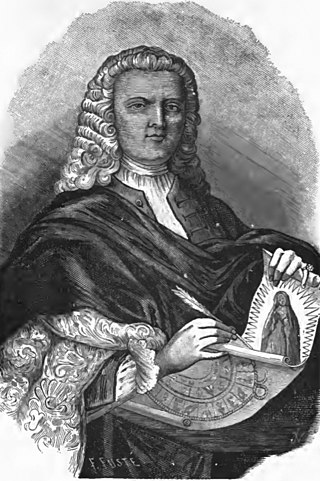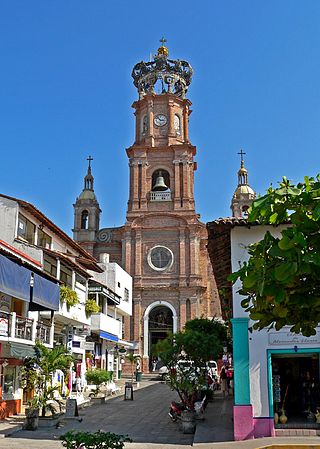Related Research Articles

Our Lady of Guadalupe, also known as the Virgin of Guadalupe, is a Catholic title of Mary, mother of Jesus associated with a series of four Marian apparitions to a Mexican peasant named Juan Diego and one to his uncle, Juan Bernardino, which are believed to have occurred in December 1531, when the Mexican territories were part of the Spanish Empire.

Gustavo A. Madero is the northernmost borough of Mexico City.

Mexican literature stands as one of the most prolific and influential within Spanish-language literary traditions, alongside those of Spain and Argentina. This rich and diverse tradition spans centuries, encompassing a wide array of genres, themes, and voices that reflect the complexities of Mexican society and culture. From ancient indigenous myths to contemporary urban narratives, Mexican literature serves as a poignant reflection of the nation's essence, inviting readers to explore its rich history, diverse culture, and collective aspirations.

The Basilica of Santa María de Guadalupe, officially called Insigne y Nacional Basílica de Santa María de Guadalupe is a basilica of the Catholic Church, dedicated to the Virgin Mary in her invocation of Our Lady of Guadalupe, located at the foot of the Hill of Tepeyac in the Gustavo A. Madero borough of Mexico City. It belongs to the Primate Archdiocese of Mexico through the Guadalupana Vicariate, which since November 4, 2018, is in the care of Monsignor Efraín Hernández Díaz, who has the title of general and episcopal vicar of Guadalupe and abbot of the basilica.

The LVI Legislature of the Congress of the Union of Mexico met from 1994 to 1997.

Miguel Mateo Maldonado y Cabrera (1695–1768) was a Mestizo painter born in Oaxaca but moved to Mexico City, the capital of Viceroyalty of New Spain. During his lifetime, he was recognized as the greatest painter in all of New Spain. He created religious and secular art for the Catholic Church and wealthy patrons. His casta paintings, depicting interracial marriage among Amerindians, Spaniards, and Africans, are considered among the genre's finest. Cabrera's paintings range from tiny works on copper to enormous canvases and wall paintings. He also designed altarpieces and funerary monuments.

Lorenzo Boturini Benaducci 1698, Sondrio, Italy – 1749, Madrid) was a historian, antiquary and ethnographer of New Spain, the Spanish Empire's dominions in North America.

Codex Escalada is a sheet of parchment signed with a date of "1548", on which there have been drawn, in ink and in the European style, images depicting the Marian apparition of Our Lady of Guadalupe to Juan Diego which allegedly occurred on four separate occasions in December 1531 on the hill of Tepeyac north of central Mexico City. If authentic, and if correctly dated to the mid-16th century, the document fills a gap in the documentary record as to the antiquity of the tradition regarding those apparitions and of the image of the Virgin associated with the fourth apparition which is venerated at the Basilica of Guadalupe. The parchment first came to light in 1995, and in 2002 was named in honour of Fr. Xavier Escalada S.J. who brought it to public attention and who published it in 1997.

The Basilica of Guadalupe or Santuario de Nuestra Señora de Guadalupe is a Roman Catholic church located in the metropolitan area of Monterrey, Nuevo León, Mexico.

San Juan Bautista Tuxtepec, or simply referred to as Tuxtepec, is the head of the municipality by the same name and is the second most populous city of the Mexican state of Oaxaca. It is part of the Tuxtepec District of the Papaloapan Region. As of the 2020 census, the city is home to a population of 103,609 and 159,452 in the municipality, though census data are often under reported for various reasons.

The Museo de América is an art, archaeology, and ethnography museum in Madrid, Spain, devoted to the whole of the Americas from the Paleolithic period to the present day. It is one of the National Museums of Spain and it is attached to the Ministry of Culture.

El Tepeyac National Park is one of a number of federally recognized national parks in Mexico that are protected natural areas and administered by the federal National Commission of Protected Natural Areas (CONANP), a subsidiary of SEMARNAT. It is one of the few green areas located north of the Mexico City suburbs. 95% of its territory is located in Gustavo A. Madero, D.F. Borough and 5% in the municipality of Tlalnepantla de Baz.

Juan Diego Cuauhtlatoatzin, also known simply as Juan Diego, was a Nahua peasant and Marian visionary. He is said to have been granted apparitions of Our Lady of Guadalupe on four occasions in December 1531: three at the hill of Tepeyac and a fourth before don Juan de Zumárraga, then bishop of Mexico. The Basilica of Our Lady of Guadalupe, located at the foot of Tepeyac, houses the cloak (tilmahtli) that is traditionally said to be Juan Diego's, and upon which the image of the Virgin is said to have been miraculously impressed as proof of the authenticity of the apparitions.
Ernesto Tamariz Galicia was a 20th-century Mexican sculptor specialized in public monuments, religious statues and funerary art.

Luis de Mena was a Mexican artist who lived and worked predominantly in the middle of the eighteenth century. Mena painted religious works and has been described as "no more than a journeyman painter in 18th century Mexico." He signed a work entitled "Most Holy Mother of Light", now on display in the Serra Museum in San Diego, California.

The Church of Our Lady of Guadalupe, known locally as the Iglesia de Nuestra Señora de Guadalupe, is a Catholic place of worship in Puerto Vallarta on the Pacific Coast of Mexico. It is open daily, with services in English available on Saturdays and mass in both Spanish and English on Sundays. The Church, built between 1930 and 1940, was constructed on the original foundations of a chapel initially dedicated to Lady Guadalupe in 1901. The Church is dedicated to Our Lady of Guadalupe, also known as the Virgin Mary. She is the patroness saint of Mexico and is considered a religious symbol of Catholic faith and female empowerment. Her feast day on 12 December is also the date of her first apparition. To celebrate this festival (fiesta), many individuals in the Mexican community display altars in their homes consisting of a painting of Our Lady of Guadalupe surrounded by flowers, candles, and other individual touches. During this time, members of many churches, including the church in Puerto Vallarta, light fireworks after the evening rosary leading up to 12 December, the day in 1531 that La Virgen de Guadalupe had her first interaction with a Mexican man named Juan Diego, which essentially established Catholicism in Mexico. She is depicted as a dark-skinned woman whose dialect is Nahuatl, which is Juan Diego's native language. Originally classified as a symbol of religion and faith, her significance in current times surpasses her role in Catholicism. Today, some see her as a figure of Mexican patriotism and liberation.
References
- ↑ Jeanette Favrot Peterson, Visualizing Guadalupe: From Black Madonna to Queen of the Americas. Austin: University of Texas Press 2014, pp. 115-16, 118.
- ↑ Peterson, Visualizing Guadalupe, p. 287, fn. 25.
- ↑ Luis Reyes García, Anales de Juan Bautista. Mexico City: Biblioteca Lorenzo Boturini, Insigne y Nacional Basílica de Guadalupe 2001.
- ↑ Peterson, Visualizing Guadalupe, p. 289, fn. 73.
- ↑ "La Guadalupana: Tres imágenes en una". Archived from the original on 2016-03-03. Retrieved 2016-03-04.
- ↑ Stafford Poole, Our Lady of Guadalupe: The Origins and Sources of a Mexican National Symbol, 1531-1797. Tucson: University of Arizona Press 1995, p. 63.
- ↑ Mariano Cuevas, S.J., Historia de la iglesia en México, Mexico City: Patria S.A., vol. 4, p.21.
- ↑ Primo Feliciano Velázquez, La aparición de Sta. Ma. de Guadalupe. Mexico City: Patricio Sanz 1931, pp. 51-55m 402, 109.
- ↑ Dunning, Brian (April 13, 2010). "Skeptoid #201: The Virgin of Guadalupe". Skeptoid . Retrieved June 19, 2017.
